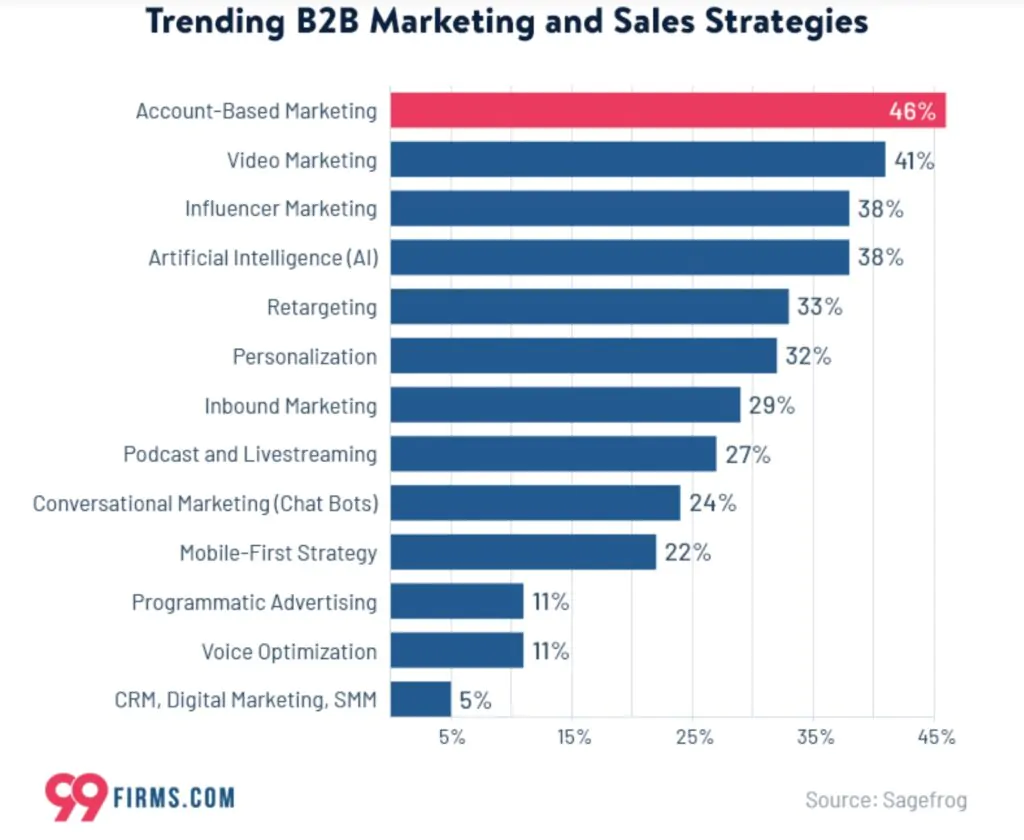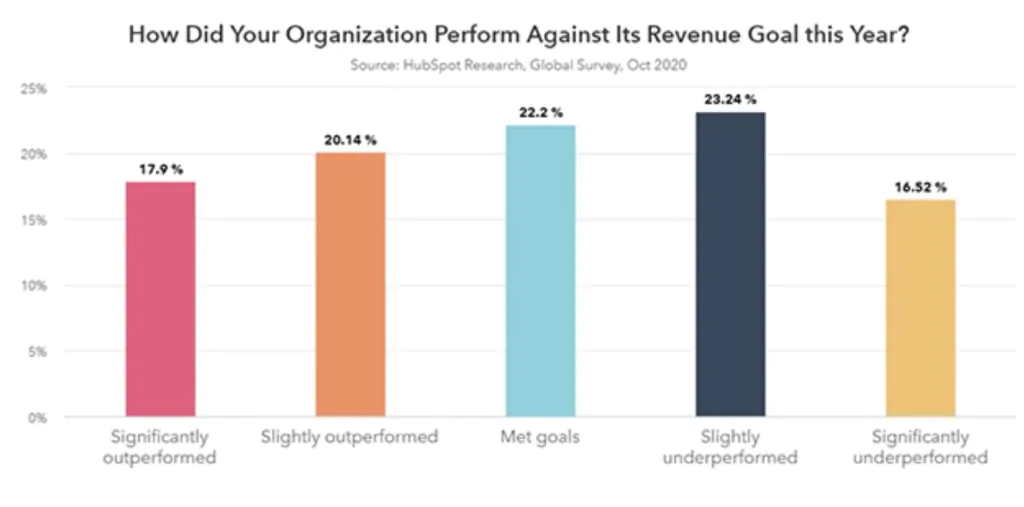Account-based marketing (ABM) is the top marketing and sales trend of 2021.
What makes this strategy so popular?
One report showed 89% of businesses using ABM saw a higher ROI than strategies that didn’t incorporate ABM.
However, there is much more to ABM than just a higher ROI. This guide helps you understand account-based marketing and how it can help your business succeed.
Key Takeaways:
- Account-based marketing relies on personal relationships with your target leads.
- ABM works best with high-value deals and large businesses.
- Unifying your sales and marketing departments is critical for ABM’s success.
What is Account-Based Marketing?
Account-based marketing is a strategic approach to targeting high-value accounts for personalized nurturing and sales tactics. Data drives ABM, which requires marketing and sales collaboration. ABM’s success in converting leads made it one of the top marketing strategies of 2021.
Source: 99Firms
Just under 80% of B2B marketers believe personalization improves customer relationships. That is why ABM’s customized sales approach has a high ROI.
However, ABM shouldn’t be your only marketing strategy. Instead, it is one in a full lineup of marketing techniques that work together to convert leads from small, low-value purchases to high-value deals worth tens of thousands. ABM is an approach that targets the latter high-value prospects.
Examples of Account-Based Marketing
You can use account-based marketing strategies and traditional marketing approaches by focusing on a specific target through your chosen medium.
Here are four account-based marketing examples.
- Recognize your target audience through your website content.
- Use your prospect’s name or reference their position and pain points in your emails.
- Interact with your audience through social media.
- Meet your prospects in person through live events and meetings.
How ABM Can Increase Your Marketing Success Rate
The list of account-based marketing benefits is nearly endless. But here are three of the top ways it can help your business by increasing your marketing success rate.
Unifies Your Teams
Disconnection between the sales and marketing teams can lose your business thousands of dollars because each team gets caught up in its strategies that don’t connect.
But with ABM, they have to work together, which increases your overall success rate.
For example, unified teams mean that the sales materials and marketing content align with the same goal, reaching the same targets. Additionally, they can share their research and customer data to create more value-based content for their audience.
Maximizes the Impact of Your Time and Resources
Account-based marketing’s strategic approach gives each resource a purpose, leading to less wasted funds, time, and resources.
For example, instead of sharing content over a dozen platforms, you can target two or three specific channels where your target account frequents, so you can guarantee your content will land in front of a decision-maker.
While the process of customizing your campaign does quickly add up in terms of costs and time, it will also yield a greater return than regular marketing efforts. However, the key to a high return is only using ABM for high-value deals.
Retains Leads and Ends in More Conversions
Personal relationships are part of a strong foundation for a successful ABM strategy. These relationships build trust with your prospects and will eventually encourage them to purchase from you. That trust will also lead to more loyal customers.
The 6 Steps of a Successful ABM Strategy
Are you ready to build your ABM strategy? Here are six steps to get you started.
1. Create and Understand Your Ideal Customer Profile
Who do you want to attract?
Use the data you collect on your customers to create an ideal profile of who is most likely to purchase your products and services. Your profile should include the following customer data:
- Industry
- Budget
- Business size
- Location
Each product you offer may have a slightly different market in mind. While your smaller products will have a broader customer profile, your larger products should be more specific in the target customer profile.
When creating a list of high-value targets for your larger services, you could even list specific companies based on research into businesses that currently have or need your services.
2. Build Brand Awareness
Your research for your customer profile will help you position your brand where your market is most likely to see it. Traditional marketing includes social media ads or influencers promoting your products on popular social sites.
However, you will take this a step further for your ABM targeted accounts.
For example, LinkedIn is the top B2B social platform for sales and marketing. So, you can reach your target audience by posting in groups they visit, commenting on their content, and addressing their industry in your feed so your brand will begin appearing before the right eyes.
3. Group and Qualify Your Leads
As leads begin to pour in from your marketing campaign, your sales and marketing teams will qualify them. If they run into high-value leads, your teams should process them differently using customized ABM strategies instead of passing them down the traditional sales funnel.
4. Market Your Products or Services
You can increase your leads and nurture interested prospects through inbound marketing techniques. If you want your inbound marketing channels to connect to your targeted ABM accounts, then find ways to customize your content.
For example, your content should position your company as an expert in your target account’s industry.
5. Educate Your Prospects
The educational step is critical for ABM’s success. Your clients are about to spend thousands of dollars on your product – so they won’t enter a deal lightly. Instead, use that united sales and marketing front to:
- Share testimonials
- Address known pain points
- Present case studies that back up your claims during your perfect sales pitch
6. Nurture and Close Your Sales
One survey showed that 40% of companies didn’t meet their sales goals in 2021. Was your company in the same boat? So what is holding your company back from fulfilling your quotas?
Source: Startup Bonsai
Most sales fall through during the nurturing stage. It’s often because sales and marketing teams may not be using the right tools to nurture those high-value leads.
A strong ABM nurturing strategy that retains and converts leads involves the following key elements:
- Understanding your lead and their driving needs
- Taking time to invest in your prospects
- Using multiple channels to connect with your target accounts
Begin Efficiently Reaching Your Target Accounts
You can lose fewer leads during lead routing and increase the conversions of your ABM targets using an automated system that tracks prospects along their journey.
Our platform increases productivity, reduces marketing overhead, and increases customer leads. Schedule a demo or talk to a sales expert to learn more.
Feature Image: istockphoto







